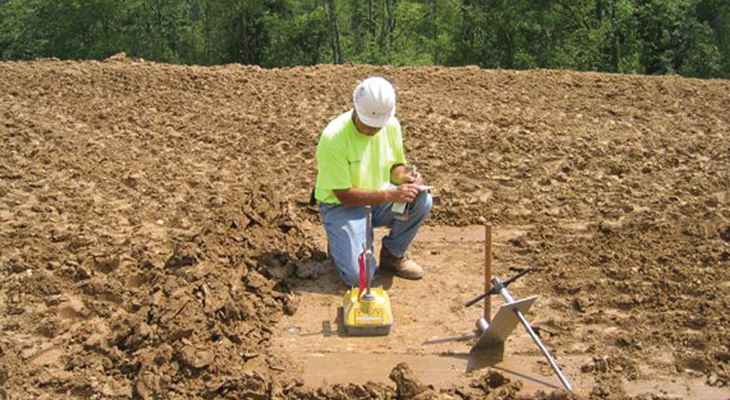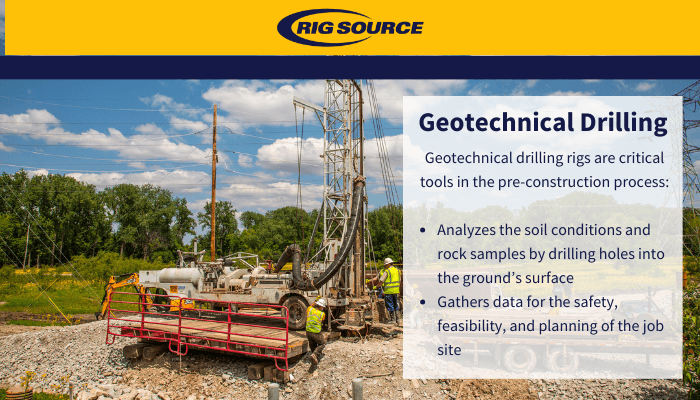Understanding Geotheta: Crucial Insights into Geotechnical Engineering Innovations
Wiki Article
Diving Into Geotechnical Solutions: the Crucial Function of Dirt Evaluation, Earthquake Danger Assessment, and Geosynthetics in Structure Lasting and Safe Structures
In the realm of building secure and lasting structures, the foundation laid by geotechnical solutions plays an extremely important role. Dirt analysis, quake danger evaluation, and the implementation of geosynthetics are important elements that make sure the honesty and longevity of buildings. By comprehending the make-up of the dirt, anticipating seismic threats, and incorporating ingenious products, designers can minimize threats and boost the strength of infrastructure. The relationship in between geotechnical solutions and the safety and security of building and constructions is elaborate, forming not just the architectural strength however likewise the ecological influence of our constructed setting. The harmony in between these aspects creates the backbone of a discussion that explores the detailed internet of aspects that add to the production of protected and sustainable towers.
Value of Soil Analysis
Comprehending the relevance of dirt evaluation is vital in guaranteeing the structural stability and security of any building task. Dirt analysis offers crucial information regarding the dirt make-up, toughness, and potential dangers that might influence the structure of a framework. By conducting detailed soil analysis, engineers can figure out the ideal structure style, construction methods, and required safety measures to alleviate any kind of potential risks.One of the primary reasons soil analysis is important is its function in determining dirt residential or commercial properties that could impact the stability of a building. Elements such as soil bearing capacity, settlement characteristics, and water content can considerably influence the structural efficiency of a building and construction task. Without appropriate dirt analysis, the foundation may go to threat of resolving unevenly, causing architectural damage or even collapse over time.
Furthermore, soil analysis aids in analyzing the danger of natural catastrophes such as earthquakes, landslides, or floods. By comprehending the soil's behavior under various problems, engineers can apply suitable measures to boost the durability of the structure and make certain the security of occupants. geotheta. To conclude, dirt analysis is a basic step in the construction procedure that must never be forgotten
Assessing Earthquake Threats
Provided the critical function of soil evaluation in identifying architectural stability, it is necessary to additionally examine quake dangers when preparation and constructing structures and facilities. Quake risk analysis involves assessing the prospective seismic dangers that a site may encounter based on its place and geological features. This process aids engineers and designers comprehend the level of danger postured by earthquakes and aids in making structures that can endure such occasions.Evaluating quake threats generally includes researching historical seismic activity in the area, identifying the site's distance to geological fault, and evaluating the dirt make-up to predict how the ground will reply to seismic waves. By conducting a detailed quake risk assessment, engineers can carry out appropriate reduction procedures, such as incorporating seismic-resistant style functions right into buildings, to enhance their durability against earthquakes.

Duty of Geosynthetics
Geosynthetics play an important function in enhancing the efficiency and sturdiness of civil design structures. These artificial materials, such as geomembranes, geotextiles, and geogrids, use a variety of features that add to the general stability and durability of numerous construction jobs. One key element of geosynthetics is their support ability, where they can improve the stamina of dirts, giving enhanced support for roads, embankments, and preserving walls. By distributing tons extra efficiently and minimizing negotiation, geosynthetics aid prevent structural failures and preserve the honesty of the constructed setting.Moreover, geosynthetics act as barriers, supplying defense versus water seepage, chemicals, and other dangerous compounds that might compromise the structural honesty of a job. They are likewise utilized in drain applications to help with the efficient circulation of water, stopping saturation and erosion of soil. Along with their technological features, geosynthetics are valued for their sustainability, as they can decrease the need for all-natural resources and reduced construction prices. On the whole, the calculated incorporation of geosynthetics is vital for guaranteeing the resilience and safety and security of contemporary infrastructure tasks.
Structure Sustainable Frameworks
The application of eco aware methods in construction is essential for fostering the advancement of lasting structures. Structure sustainable structures includes utilizing materials and layout techniques that reduce ecological effect, reduce energy intake, and promote long-lasting resilience. Including sustainable methods such as making use of recycled products, optimizing power efficiency, and applying green building accreditations like LEED can significantly enhance the environmental efficiency of a structure.One secret element of structure lasting structures is the efficient usage of sources. This includes creating structures that make the most of natural light, ventilation, and insulation to minimize the dependence on fabricated lighting, heating, and cooling systems. Additionally, integrating renewable resource sources such as solar panels or wind turbines can even more reduce the carbon footprint click this site of a structure while also possibly reducing long-lasting energy expenses.
Additionally, lasting frameworks usually focus on water preservation by including attributes like rain harvesting systems, low-flow components, and drought-resistant landscape design. By embracing these eco pleasant methods, building tasks can not just lower their ecological influence however likewise add to developing much healthier and extra durable developed atmospheres for future generations.
Ensuring Safety in Construction
In the realm of sustainable construction techniques, a basic concern is guaranteeing the safety of all personnel associated with the structure process. Safety and security in building and construction includes various facets, including using correct personal safety devices (PPE), adherence to safety methods, regular training on hazard acknowledgment and mitigation, and the implementation of emergency situation reaction strategies. Construction websites are inherently risky atmospheres, with potential dangers varying from drops and falling challenge electrical accidents and structural collapses (geotheta). visit here It is crucial for construction business to focus on safety measures to avoid injuries and accidents.
Conclusion
To conclude, dirt analysis, earthquake danger analysis, and making use of geosynthetics play crucial duties in guaranteeing the sustainability and security of frameworks. By understanding the residential properties of dirt, evaluating earthquake threats, and making use of geosynthetics for reinforcement, designers can construct frameworks that are both resistant and durable. It is necessary for building and construction professionals to prioritize these geotechnical services to develop secure and lasting structures for the future.Dirt evaluation, quake risk assessment, and the implementation of here geosynthetics are important elements that guarantee the stability and durability of buildings. Soil analysis supplies important info regarding the soil structure, toughness, and possible threats that might impact the foundation of a structure.One of the primary factors dirt evaluation is crucial is its function in determining soil homes that might impact the stability of a structure.In verdict, dirt analysis, earthquake threat analysis, and the use of geosynthetics play vital functions in guaranteeing the sustainability and safety of frameworks. By recognizing the residential properties of soil, evaluating quake dangers, and using geosynthetics for reinforcement, designers can develop structures that are both sturdy and durable.
Report this wiki page